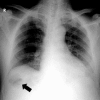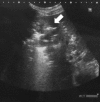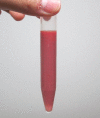Life-threatening emphysematous liver abscess associated with poorly controlled diabetes mellitus: a case report
- PMID: 28264703
- PMCID: PMC5340034
- DOI: 10.1186/s13104-017-2445-8
Life-threatening emphysematous liver abscess associated with poorly controlled diabetes mellitus: a case report
Abstract
Background: Emphysematous liver abscesses are defined as liver abscesses accompanied by gas formation. The fatality rate is extremely high at 27%, necessitating prompt intensive care.
Case presentation: The patient was a 69-year-old Japanese man with type 2 diabetes. He visited the emergency outpatient department for fever and general malaise that had been ongoing for 2 weeks. Abdominal computed tomography revealed an abscess 5 cm in diameter accompanied by gas formation in the right hepatic lobe. Markedly impaired glucose tolerance was observed with a blood sugar level of 571 mg/dL and a glycated hemoglobin level of 14.6%. The patient underwent emergency percutaneous abscess drainage, and intensive care was subsequently initiated. Klebsiella pneumoniae was detected in both the abscess cavity and blood cultures. The drain was removed 3 weeks later, and the patient was discharged.
Conclusion: Emphysematous liver abscesses are often observed in patients with poorly controlled diabetes, and the fatality rate is extremely high. Fever and malaise occasionally mask life-threatening infections in diabetic patients, necessitating careful examination.
Keywords: Diabetes mellitus; Emphysematous liver abscess; Gas-forming pyogenic liver abscesses.
Figures




Similar articles
-
Emphysematous liver abscess in a 58-year-old woman.CMAJ. 2018 Sep 17;190(37):E1111. doi: 10.1503/cmaj.180267. CMAJ. 2018. PMID: 30224444 Free PMC article. No abstract available.
-
A rare presentation of systemic emphysematous infections secondary to Klebsiella pneumoniae bacteremia in a diabetic patient.J Emerg Med. 2015 May;48(5):548-50. doi: 10.1016/j.jemermed.2014.12.035. Epub 2015 Feb 7. J Emerg Med. 2015. PMID: 25665468
-
[A case of gas-forming pyogenic liver abscess].Nihon Shokakibyo Gakkai Zasshi. 2007 Jul;104(7):1063-8. Nihon Shokakibyo Gakkai Zasshi. 2007. PMID: 17611383 Japanese.
-
Emphysematous liver abscesses complicated by septic pulmonary emboli in patients with diabetes: two cases.Intern Med. 2013;52(1):141-5. doi: 10.2169/internalmedicine.52.8737. Epub 2013 Jan 1. Intern Med. 2013. PMID: 23291690 Review.
-
Pyogenic liver abscess with a focus on Klebsiella pneumoniae as a primary pathogen: an emerging disease with unique clinical characteristics.Am J Gastroenterol. 2005 Feb;100(2):322-31. doi: 10.1111/j.1572-0241.2005.40310.x. Am J Gastroenterol. 2005. PMID: 15667489 Review.
Cited by
-
Ruptured Emphysematous Liver Abscess: An Unusual Presentation in Kochs.Clin Pract. 2021 Apr 2;11(2):200-204. doi: 10.3390/clinpract11020029. Clin Pract. 2021. PMID: 33918109 Free PMC article.
-
Pneumoperitoneum Due to Ruptured Gas Forming Candida Liver Abscess.J Clin Exp Hepatol. 2023 Sep-Oct;13(5):921-922. doi: 10.1016/j.jceh.2023.03.002. Epub 2023 Mar 11. J Clin Exp Hepatol. 2023. PMID: 37693273 Free PMC article. No abstract available.
-
Emphysematous Liver Abscess and Disseminated Hypervirulent Klebsiella pneumoniae Infection in a Patient from Southern India.Indian J Crit Care Med. 2022 Mar;26(3):381-383. doi: 10.5005/jp-journals-10071-24131. Indian J Crit Care Med. 2022. PMID: 35519904 Free PMC article.
-
Emphysematous liver abscess in a 58-year-old woman.CMAJ. 2018 Sep 17;190(37):E1111. doi: 10.1503/cmaj.180267. CMAJ. 2018. PMID: 30224444 Free PMC article. No abstract available.
-
Fatal systemic emphysematous infection caused by Klebsiella pneumoniae: A case report.World J Clin Cases. 2022 Mar 16;10(8):2610-2615. doi: 10.12998/wjcc.v10.i8.2610. World J Clin Cases. 2022. PMID: 35434061 Free PMC article.
References
Publication types
MeSH terms
LinkOut - more resources
Full Text Sources
Other Literature Sources
Medical

